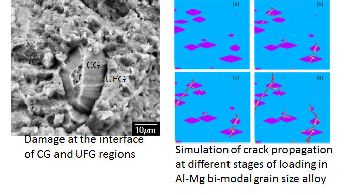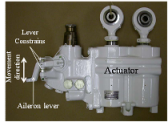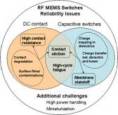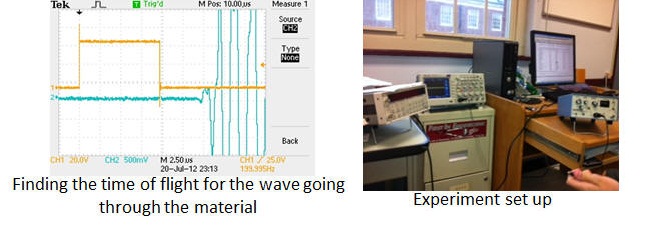Current Research Projects

A Novel Cu/CNT Material System for Through Silicon Via Interconnects
The objectives of this project is to develop and examine a new material system for interconnects used inmicro/nanoelectronics. The material system proposed in this study is expected to overcome several issues of current copper interconnects. It will make it possible to fabricate nanoscale interconnects with a low resistance and high strength and provide a durable solution for next generation of nano-interconnects. Utilizing advanced micro/nanofabrication processes, carbon nanotubes (CNTs) will be grown inside through silicon vias and copper matrix will be added to enhance the density, strength and conductivity of the CNTs. Electrical and mechanical tests and simulations will be used to evaluate the reliability and electrical functionality of the interconnects.

Size and Anisotropy Effects in Micro/Nano-bonds with Comparable Grain and Bond Sizes
This project focuses on understanding the kinetics of bond formation and the associated mechanical behavior of different phases that are formed in micro/nanoscale bonds with comparable structural and microstructural sizes. Additionally, we aim to establish a scientific relationship between the microstructure and governing mechanisms of damage and deformation and mechanical properties and fatigue behavior.
Selected Publications:
Abdelhadi, O. and Ladani, L., 2012. IMC growth of Sn-3.5Ag/Cu system: combined chemical reaction and diffusion mechanisms. Journal of Alloys and Compounds, 537, pp. 87-99.
Abdelhadi, O., and Ladani, L., 2013. Mechanical properties of single grain Cu6Sn5 intermetallic compound (IMC) using combined nanoindentation and electron backscatter diffraction (EBSD) imaging. 2013 TMS Annual Meeting & Exhibition.

Anisotropic Deformation and Damage Mechanisms in Al-Mg Bi-modal Grain Size Alloy
Nanocrystalline and ultrafine grain metals show remarkable mechanical behavior at room temperature. However, their behavior at high temperatures are not well understood. The project goals have been to understand governing mechanisms of deformation in these materials under different types of loading conditions including high temperatures. The results are used to design and optimize the materials microstructure for high strength high ductility metals for variety of applications.
Selected Publications:
Magee, A., Ladani, L., Toping, T., and Lavernia, E.J., 2012. Effects of Tensile Test Parameters on the Mechanical Properties of a Bimodal Al-Mg Alloy. Acta Materialia.
Harvey, E. and Ladani, L., 2012. Complete mechanical characterization of nanocrystalline Al-Mg alloy using nanoindentation. Mechanics of Materials, 52, pp. 1-11.

Electron beam additive fabrication technology for rapid manufacturing of space vehicle hardware
The overall goal of the proposed research is to achieve fundamental scientific understanding of the EBAF process and to broaden its effective usage for rapid manufacturing (RM) of space vehicle hardware. Mechanical behavior of parts produced using EBAF process will be examined at different scales and variety of load conditions.
Past Research Projects

Fatigue Damage in T-38 Aileron Lever
Crack initiation and propagation due to cyclic mechanical fatigue damage in the T-38 aileron lever is modeled using a continuum damage modeling approach in conjunction with a “successive initiation” technique. “Successive initiation” is a continuum based damage propagation methodology that is based on updating the state of damage in material and accumulating damage in individual elements according to their stress-life history. This approach successfully predicts the location of crack initiation, propagation path and propagation rate.

Microstructural Finite Element of Fatigue Crack Initial and Propagation in Bi-Modal Grain Size Alloys
A fatigue crack propagation model was developed for bi-modal grain size alloys and damage model constants for bi-modal grain size aluminum were generated. The model was then used in 2D and 3D microstructural finite element models to model crack initiation and propagation. Grains with different properties were modeled using global-local modeling approach.

Reliability of RFN/MEMS for High Power Application
This research focused on modeling and simulation of RF M/NEMS contact switches and to determine the critical factors that may affect the surface degradation thereby causing failure due to friction or increased contact resistance.

Development of a crack Sensor for High Temperature Applicaiton
Crack sensors are used to detect crack initiation and propagation in different structures due to different types of environmental loading. The proposed research plan is for initiation and development of a crack sensor for high temperature applications, such as reactors and furnaces in energy conversion systems where available techniques are not feasible. The focus was on micro scale application which resulted in design of a micro scale sensor for evaluating the state of damage in micro scale materials.

Effects of Manufacturing variables on Quality and Durability of Pd-Free solder Interconnects
In summary there were two objectives to this study; first to investigate the effect of manufacturing variability on generation of defects and effect of defects, in particular voids, on thermo-mechanical durability of Pb-free solder joints and second to investigate the impact of design variables on generation of defects and impact of defects, in particular voids, on thermal performance of the micro joints. Both experiment and finite element modeling and simulation were carried out.

Development of Hybrid Level Screening Methodology
The main objectives of this project was to assess the effectiveness of burn-in for hybrid microcircuits and feasibility of reducing burn-in time, review influence of assembly defects on durability of Sn/Pb interconnects and set up a test plan to study the effect of manufacturing variabilities on durability of lead-free solder interconnects. The study was conducted on hybrid pacemaker packages.

In Vivo Mechanical Stimulations of Nerves and Tissues using Novel Micro-electro Mechanical System
The goal of this project was to develop a micro-bio-electromechanical system that can be used to determine the mechanical behavior of tissues at microscale.